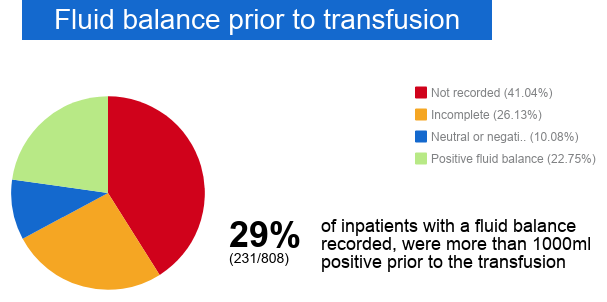Transfusion associated circulatory overload audit 2017
Key objectives
- A comparison of practice against BCSH, SHOT and NICE recommendations
- A greater understanding of how patients at risk of TACO are managed
- The publication of recommendations for best practice
- The production and distribution of tools to aid local practice improvement
What did we audit?
We audited people aged 60 years or older who had received a red cell transfusion in March or April 2017.
Who took part?
We audited 4580 patients from 157 sites over 2 months in 2017. 2461 inpatient transfusions and 2113 outpatient transfusions. Median age 78 years.
What did we find?
- Full report (PDF)
- Key points (PDF)
Assessing risk of TACO
89% of audited inpatients had at least one additional risk factor for TACO apart from age, the most common reason was hypoalbuminaemia (52%). Only 20.5% of inpatients had risk assessment for TACO performed and documented in the notes. Only 43% of outpatients were seen by the person prescribing the blood in the week prior to transfusion.
Pre-emptive measures to minimise risk
29% of inpatients with a fluid balance recorded were more than 1000mls positive prior to the transfusion

Diagnosis and treatment of TACO
4.3% of inpatients developed acute or worsening respiratory distress
1.7% of outpatients were re-admitted within 24 hours of the transfusion, of which 20% were readmitted with worsening respiratory symptoms.
Reporting of TACO
33% of inpatients diagnosed with TACO by the hospital were reported to SHOT.
Tools to help improve practice
References
S Morton, J Grant-Casey, P Bolton-Maggs, U Tandon, J Addison, A Bartholomew, L Estcourt. Skating on Thin Ice: National Audit of TACO Demonstrates Poor Recognition of Risk Factors. Blood 2017 130:2406; Abstract
Please cite this document as:
The TACO Audit Working Group on behalf of the National Comparative Audit of Blood Transfusion. 'The 2017 audit of Transfusion Associated Circulatory Overload' (2018). https://doi.org/10.71745/rara-n147
